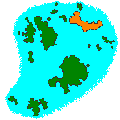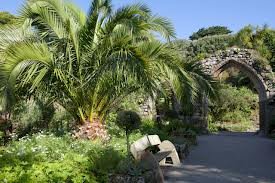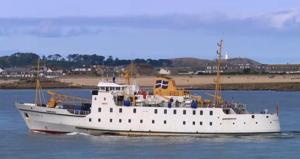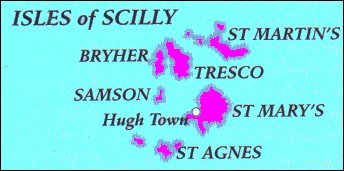


The Fortunate Islands
Web: www.islesofscilly-travel.co.uk
Web: www.visitislesofscilly.com
Web: www.simplyscilly.co.uk
Web: www.visitcornwall.com/destinations/isles-of-scilly
Web: www.ios-wildlifetrust.org.uk
Council of the Isles of Scilly
Twenty eight miles south west of Land's End in clear, blue Atlantic water, fabled in distant legend to be the hill tops of the submerged and legendary land of Lyonesse, these beautiful islands of low hills exude a timeless peace and natural tranquillity.
 Tresco Abbey Gardens |
 Getting To The Islands |
All the inhabited islands offer excellent, modern accommodation and amenities, safe sandy beaches, pubs and opportunities for outdoor sport. There are many sites of historical interest throughout the islands and the birdwatching and scuba diving are renowned and, most importantly, Scilly is virtually crime-free, making it one of the safest environments in the world. The population of the islands was 2,203 at the 2011 census.
Spring and autumn are especially good times to visit the islands. In spring the early flowering of daffodils and narcissi carpet the island's small fields and in the autumn there is the opportunity to spot rare and wonderful birds as they make their way to the warmer climes of southern Europe or have been blown across from America.
The warm climate permits a variety of tropical vegetation to grow outside and the mild winters encourage a flourishing flower industry. The islands are free of pollution and their outstanding beauty and wildlife are protected by an environmental trust. Seals, dolphins and puffins can be seen, together with rare migratory birds that visit in spring and autumn.
The submerged reefs to the west of the islands proved treacherous to ships without modern navigation aids, and in 1707 the Association and three other ships commanded by Rear-Admiral Sir Cloudesley Shovell were wrecked with 1700 lives lost. Today a wealth of treasure from wrecks around the islands provides a romantic jigsaw of maritime history, just as the fascinating archaeological sites all over the islands contribute to our picture of Scillonian's since the dawn of man.

During the English Civil War, the Parliamentarians captured the isles, only to see their garrison mutiny and return the isles to the Royalists. By 1651 the Royalist governor, Sir John Grenville, was using the islands as a base for privateering raids on Commonwealth and Dutch shipping. The Dutch admiral Maarten Tromp sailed to the isles and on arriving on 30th May 1651 demanded compensation. In absence of compensation or a satisfactory reply, he declared war on England in June. It was during this period that the Three Hundred and Thirty Five Years' War started between the Isles and the Netherlands. In June 1651, Admiral Robert Blake recaptured the Isles for the Parliamentarians
The Isles of Scilly is a wonderful holiday destination, but the islands are much more than a group of beautiful islands complete with glorious beaches, wonderful views, magnificent seascape and abundant wildlife. Scilly has bred vigorous, successful people throughout history from master mariners, flower growers and shipbuilders. Islands normally attract independent people and it will come as no surprise to discover that over one third of the working population is self-employed from farmers to fishermen, shopkeepers, guest house owners, boatmen, carpenters and carriers. Most of the work on the islands is centred on tourism, but the ancient industries - farming and fishing continue.
In 1552, Thomas Godolphin became captain (or governor) of the Isles of Scilly, and lessee under the Duchy of Cornwall. Later the Isles of Scilly were passed down to Sir Francis Godolphin later still the lease was renewed to Sir William Godolphin and then to Sidney Lord Godolphin. In 1834, Augustus John Smith acquired the lease on the Isles of Scilly from the Duchy of Cornwall and set about changing the islanders' way of life, expelling those who could not find a job locally and evicting some of the inhabitants of smaller islands, in a manner similar to that practised in the Scottish clearances. In 1855, he expelled the ten inhabitants of Samson, in order to turn the island into a deer park (the deer did not like the habitat, and escaped). Smith also had to promise to spend £5,000 building a new quay, and a further £3,400 on the parish church. He arrived on Scilly in 1834 as Lord Proprietor and embarked on a huge construction plan, building schools on most of the islands, offering employment and paying wages out of his own pocket. With no property on Scilly sufficiently large enough for his personal needs, Smith built Tresco Abbey as his private residence, overlooking two lakes in the grounds of the old St. Nicholas Priory. His son Thomas Algernon Smith-Dorrien-Smith took over as Governor in 1872 and then in 1918 his son Arthur Algernon Dorrien-Smith took over. In 1920 ownership reverted to the Duchy of Cornwall.
Governors of Scilly
1568–1608 Sir Francis Godolphin (1540–1608)
1608–1613 Sir William Godolphin of Godolphin (1567–1613)
1613–1636 William Godolphin (1611–1636)
1636–1643 Sidney Godolphin (1610–1643)
1643–1646 Sir Francis Godolphin of Godolphin (1605–1647)
1647–1648 Anthony Buller (1613–1679)
1649–1651 Sir John Grenville (1628-1701)
1651–1660 Parliamentary control
1660–1667 Sir Francis Godolphin of Godolphin (1605–1667) (restored to office)
1667–1700 Sidney Godolphin, 1st Earl of Godolphin (1645–1712)
1700–1732 Sidney Godolphin (1652–1732)
1733–1766 Francis Godolphin, 2nd Earl of Godolphin (1678–1766)
1766–1785 Francis Godolphin, 2nd Baron Godolphin (1706–1785)
1785–1799 Francis Osborne, 5th Duke of Leeds (1751–1799)
1799–1831 George Osborne, 6th Duke of Leeds (1775–1838)
1834–1872 Augustus John Smith (1804–1872)
1872–1918 Thomas Algernon Smith-Dorrien-Smith (1846–1918)
1918–1920 Arthur Algernon Dorrien-Smith (1876–1955)
Today, tourism is estimated to account for 85% of the islands' income. The islands have been successful in attracting this investment due to their special environment, favourable summer climate, relaxed culture, efficient co-ordination of tourism providers and good transport links by sea and air to the mainland. The majority of visitors stay on St. Mary's, which has a concentration of holiday accommodation and other amenities.
The island farms resemble the kind of smallholding that still flourished on the mainland England at the end of the 19th century with small fields and high hedges, and because Scilly is blessed with a remarkably temperate climate, with frost and snow being extremely rare, the growers produce very high quality, heavily scented early spring flowers.
Lobster, crayfish and crabs are pulled up in traditional inkwell pots and hake, turbot, sole, plaice, megrim, whiting and monkfish are caught in nets, trawls or on lines by the small fleet of some thirty five local boats. Much of the fish is exported to Newlyn and then on to Europe, but the fishermen also supply the local hotels, guest houses and restaurants.
There are good communications to connect the islands to the mainland and regular launch services, seven days a week, which link the islands to each other. The islands were not subject to Income Tax until 1954, and there was no motor vehicle excise duty levied until 1971.
Electricity is supplied to the St. Mary's by underwater cable. This was installed in 1985 before which date, St. Mary's ran from its own power station and the off islands had their own generators for individual properties. In 1989 the islands were connected to the National Grid.
The islands are served by Halangy Down radio and television transmitter on St. Mary's, which is a relay of the main transmitter at Redruth and broadcasts BBC Radio 1, 2, 3, 4 and BBC Radio Cornwall and the range of Freeview television and BBC radio channels. Radio Scilly, a community radio station, was launched in September 2007.
The Scillonian is the ferry link to the islands and provides a reliable service throughout the summer months to St. Mary's Harbour. It is operated by www.islesofscilly-travel.co.uk.
St. Mary's Airport provides a lifeline air link between the mainland and the Isles of Scilly. It plays a lead role in transporting visitors, locals and key workers to and from the Islands. It is operated by the Council of the Isles of Scilly, Tel: (01736) 334220, Web: St. Mary's Airport.
There is a golf club with a nine-hole course (each with two tees) situated on the island of St. Mary's, near Porthloo and Telegraph. The club was founded in 1904 and is open to visitors.
The town's Tourist Information Centre is at Hugh Street, Hugh Town, TR21 0LL.
Walk Scilly - Early April.
Daymark Music Festival is held on St. Martin's at Easter.
World Pilot Gig Championships - End of April.
Isles of Scilly Folk Festival - End of May.
Tresco Triathlon - Mid June.
Isles of Scilly Round the Island Race - Early August.
Taste of Scilly Festival - Early September.

St. Mary's St. Martin's Bryher Tresco St. Agnes The Uninhabited Islands The Scillonian Cornwall's Ferrys
Isles of Scilly Museum Star Castle Cromwell's Castle King Charles's Castle Old Blockhouse Oliver's Battery Cornish Gig Racing
St. Martin's Daymark Tresco Abbey Gardens Seven Stones Lightship Shipwrecks Around The Isles of Scilly Getting To The Islands